lives in bee nests and disperses on bees, but feeding behavior is uknown
Cerophagopsis Zachvatkin, 1941Zachvatkin, 1941:
Zachvatkin, A. A. 1941. Tiroglifoidnue kleshchi Tyroglyphoidea [=Tyroglyphoid mites Tyroglyphoidea]. In Fauna SSSR: Paukoobraznuye, ed. S. A. Zernov, 475. Moscow-Leningrad: Akademiya Nauk SSSR (translated to English in a separate publication).
Superorder Acariformes » Order Sarcoptiformes » Suborder Oribatida » Infraorder Desmonomata » Hyporder Astigmata » Family Acaridae » Genus Cerophagopsis
Cerophagopsis skorikovi Zachvatkin, 1941Zachvatkin, 1941:
Zachvatkin, A. A. 1941. Tiroglifoidnue kleshchi Tyroglyphoidea [=Tyroglyphoid mites Tyroglyphoidea]. In Fauna SSSR: Paukoobraznuye, ed. S. A. Zernov, 475. Moscow-Leningrad: Akademiya Nauk SSSR (translated to English in a separate publication).
Rhypoglyphus. One historical paper considers Cerophagopsis as part of Cerophagus (not accepted here).
Phoretic phoretic:
Pertaining to phoresy; using another organism (i.e., a host) for dispersal to new habitats. Phoresy can be distinguished from parasitism because feeding typically does not occur during phoresy.
deutonymph: Anterior extension of coxal apodemeapodeme:
Internal sclerite that serves as an attachment site for muscles. Most commonly used (as "coxal apodeme") to describe elements of coxae fused to the ventral body in Acariformes (coxae are free and not fused to the body in Parasitiformes), and may be variously referred to as ventral, sternal, anterior, or posterior.
 III long, almost reaching lateral sides of body in the type species (C. skorikovi) (Fig. 4) but not in other described species. Coxal setae 1a filiform, not conoidal (Fig. 4). Coxal setae 3a, 4a alveolar (not conoidal) (Fig. 4). Empodial clawsEmpodial claw:
III long, almost reaching lateral sides of body in the type species (C. skorikovi) (Fig. 4) but not in other described species. Coxal setae 1a filiform, not conoidal (Fig. 4). Coxal setae 3a, 4a alveolar (not conoidal) (Fig. 4). Empodial clawsEmpodial claw:
Claw-like, membranous, or pad-like structure of setal origin. Present only on the pretarsus in Acariformes. In Astigmata, it is the only claw on the pretarsus and often referred to simply as the claw. In the remaining Acariformes, may be accomanied by two lateral claws. Also known as empodium, pretarsal empodium, or central claw.
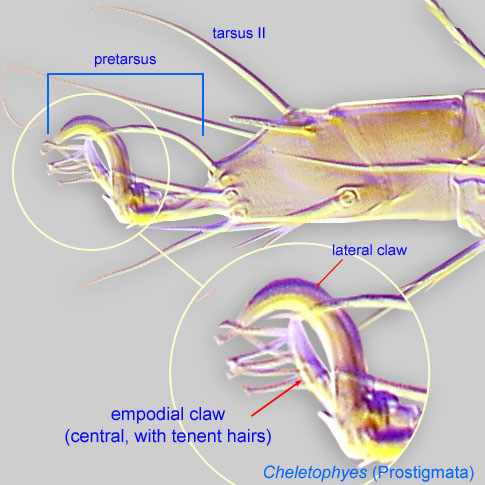 I-IV somewhat large, subequal, not twisted, each with a basal flange (Figs. 4, 7; in images empodial clawsempodial claw:
I-IV somewhat large, subequal, not twisted, each with a basal flange (Figs. 4, 7; in images empodial clawsempodial claw:
Claw-like, membranous, or pad-like structure of setal origin. Present only on the pretarsus in Acariformes. In Astigmata, it is the only claw on the pretarsus and often referred to simply as the claw. In the remaining Acariformes, may be accomanied by two lateral claws. Also known as empodium, pretarsal empodium, or central claw.
 referred to as claws for simplicity). One long seta on tarsustarsus:
referred to as claws for simplicity). One long seta on tarsustarsus:
Terminal segment (also known as podomere or palpomere) of legs or palps. In Parasitoformes it can be subdivided into telotarsus and basitarsus.
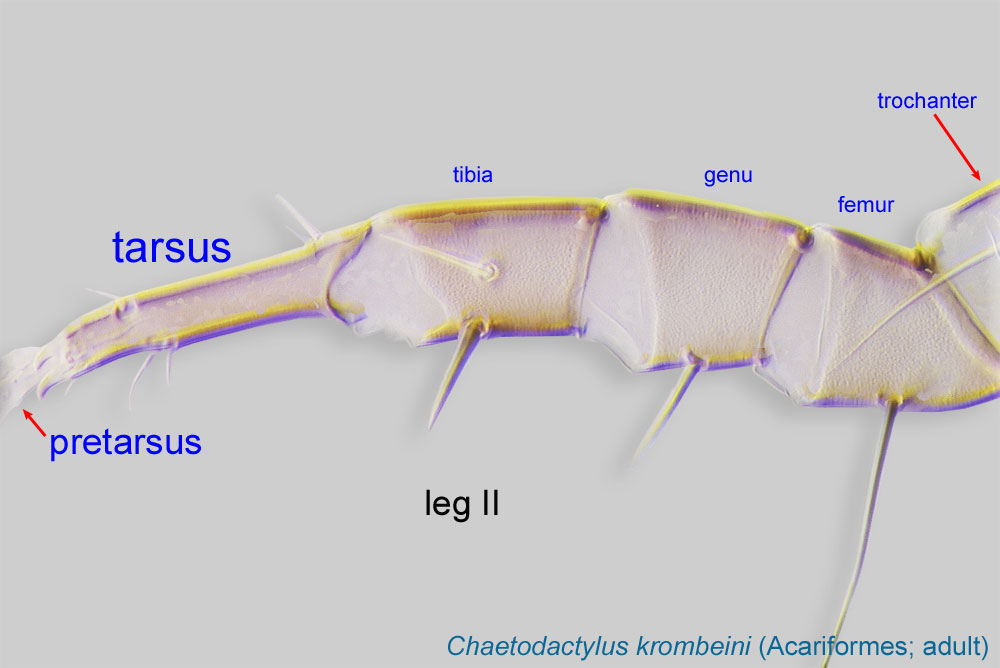 IV (Fig. 9). Tarsal setae aa I (Figs. 5, 6) and ba I-II present (Fig. 5).
IV (Fig. 9). Tarsal setae aa I (Figs. 5, 6) and ba I-II present (Fig. 5).
Adult: Setae ve short, not barbed, situated on the same transverse line as vi on prodorsalprodorsal:
Pertaining to the prodorsum.
sclerite (Fig. 15). Supracoxal seta scx I thin, smooth, bent in basal portion (Fig. 15). Grandjean's organGrandjean's organ:
Paired, finger-shaped, lobe-shaped, or otherwise elaborated structure situated on the lateral sides of the propodosoma, typically in association with the podocephalic canal. Its free edges may be strongly fimbriate.
rounded and fimbriate. SolenidiaSolenidion:
Thin-walled, terminally rounded or pointed filiform or peglike structure that is not birefringent in polarized light (unlike common setae in Acariformes). Often appears striated because of its internal structure. Found on the palpal tarsus on the gnathosoma and may also occur on the tarsus and tibia, less frequently on the genu, and occasionally on the femur of legs I-IV. In Acariformes, leg solenidia often arise from unsclerotized areas.
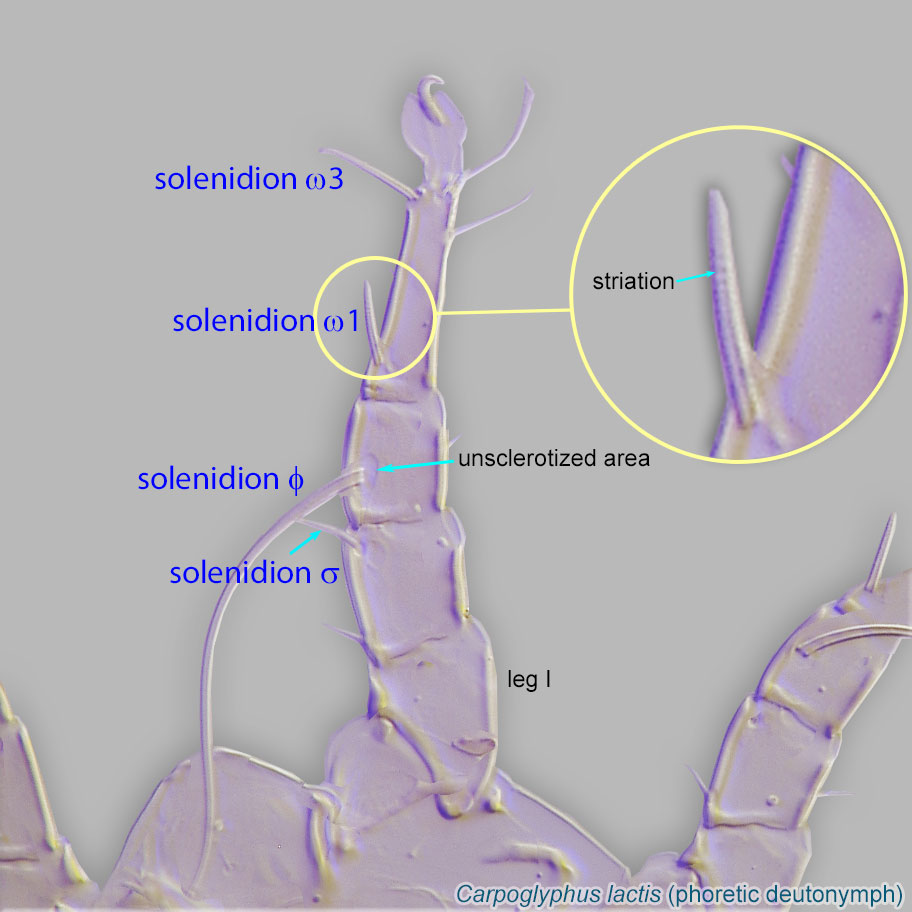 σ" and σ' on genugenu:
σ" and σ' on genugenu:
Leg or palp segment (also known as podomere or palpomere) between tibia and femur.
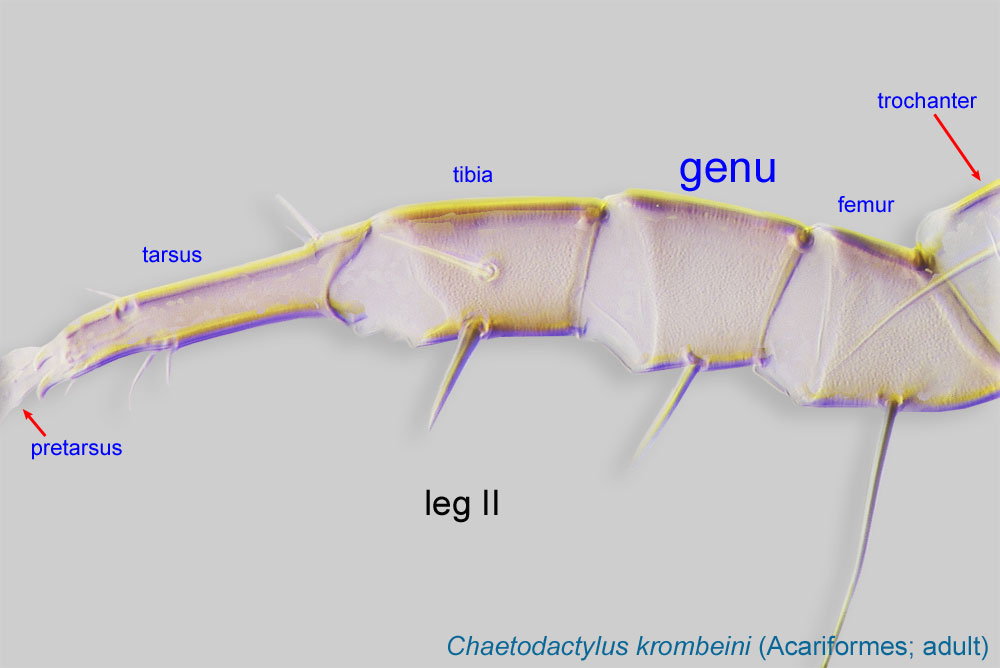 I subequal (Fig. 15). External scapular setae se positioned distinctly anterior to level of internal scapular setae (si) (Fig. 15).
I subequal (Fig. 15). External scapular setae se positioned distinctly anterior to level of internal scapular setae (si) (Fig. 15).
A dichotomous key to phoreticphoretic:
Pertaining to phoresy; using another organism (i.e., a host) for dispersal to new habitats. Phoresy can be distinguished from parasitism because feeding typically does not occur during phoresy.
deutonymphsdeutonymph:
Ontogenetic stage between protonymph and tritonymph (or adult, if tritonymph is absent). See <a href="index.cfm?pageID=1720">Life stages page</a> for more details.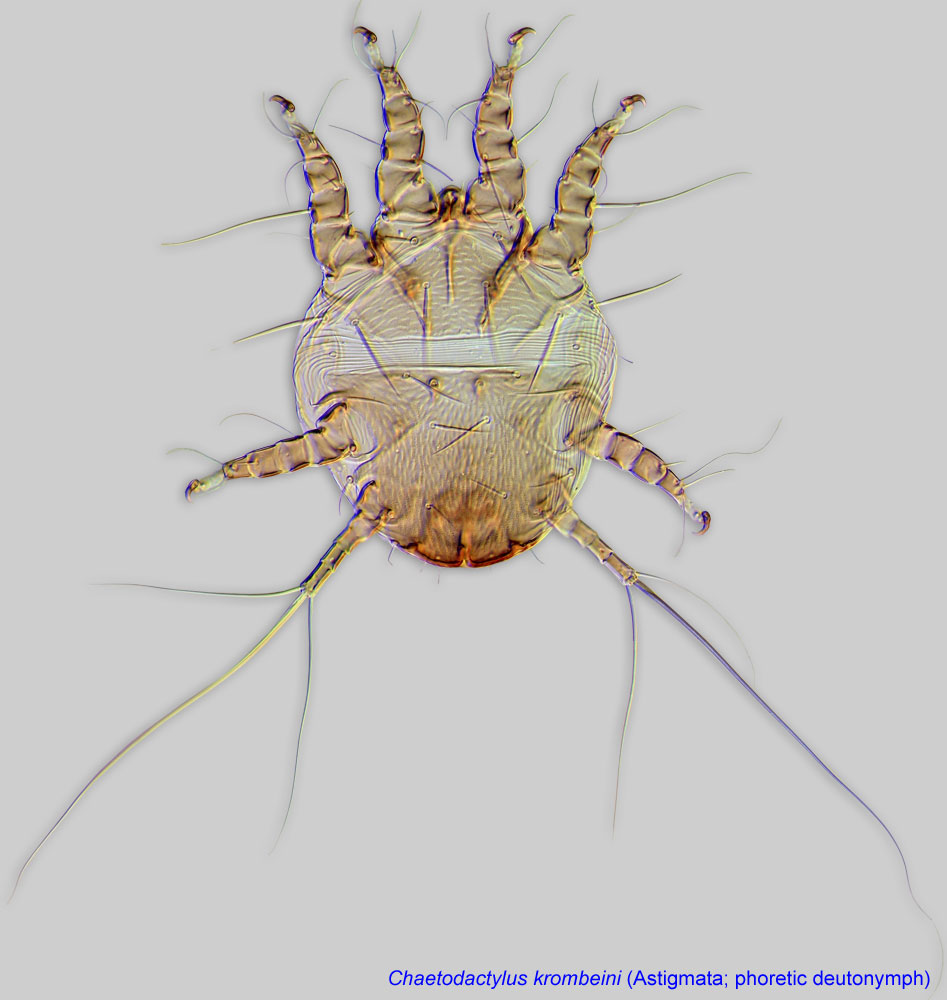 is available in Fain and Heard, 1987Fain and Heard, 1987:
is available in Fain and Heard, 1987Fain and Heard, 1987:
Fain, A. amp; T. A. Heard. 1987. Description and life cycle of Cerophagus trigona spec. nov. (Acari, Acaridae), associated with the stingless bee Trigona carbonaria Smith in Australia. Bulletin de l'Institut Royal des Sciences Naturelles de Belgique Entomologie.57: 197-202.. Note: (i) Cerophagopsis is treated as part of Cerophagus in this key; (ii) C. indicus, known from adults only, was not included in this key.
Similar to Megachilopus but differs in having claws with basal flanges (Fig. 7) (no flanges in Megachilopus, Fig. 8) and in the absence of ventral ambulacral extension on tarsustarsus:
Terminal segment (also known as podomere or palpomere) of legs or palps. In Parasitoformes it can be subdivided into telotarsus and basitarsus.
 I (Fig. 7) (with extension in Megachilopus, Fig. 8). Similar to Cerophagus but differs by the presence of tarsal setae aa I (Figs. 5, 6) in all stages (absent in Cerophagus). See also Sennertionyx.
I (Fig. 7) (with extension in Megachilopus, Fig. 8). Similar to Cerophagus but differs by the presence of tarsal setae aa I (Figs. 5, 6) in all stages (absent in Cerophagus). See also Sennertionyx.
Known from Eastern Palaearctic, Oriental, Afrotropical, and Australian region. Undescribed species have been found in the Nearctic and Neotropical regions (our data).
Most species occur on leafcutting and resin bees (Megachile), especially subgenus Callomegachile and relatives that line cells of their nests with plant resin. One species has been described from the megachilid Heriades erythrosoma endemic to Madagascar, and another from Tetragonula carbonaria (Australia). Occasional records include the sand wasp Bembix borrei (family Sphecidae) and sugary stored products.
permanentpermanent:
associated exclusively with bees or their close relative, wasps; cannot live without these hosts
 disperse on bee hosts (Fig. 16).
disperse on bee hosts (Fig. 16).